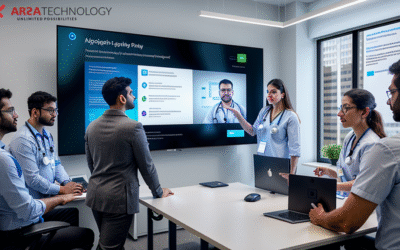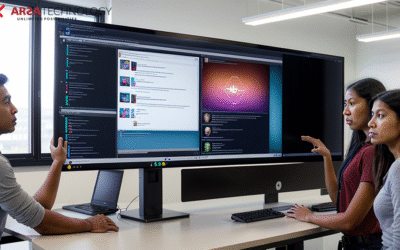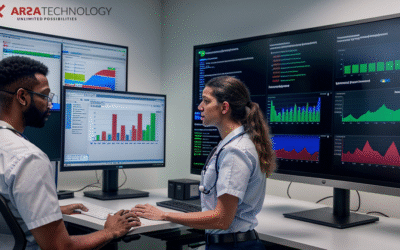Introduction: Overcoming Scalability Challenges in the Broadcasting Industry
The broadcasting industry operates at a relentless pace, demanding constant innovation and efficiency across all its operations. From managing viewer feedback and advertising inquiries to technical support and content acquisition, call centers are the frontline of engagement. However, as global audiences expand and interaction channels multiply, these call centers face a significant hurdle: scalability challenges. Traditional methods of call monitoring, manual transcription, and quality assurance are simply not equipped to handle the sheer volume of interactions, leading to bottlenecks, inconsistent service quality, and missed opportunities for critical business insights.
For broadcasting companies striving to maintain a competitive edge, the ability to rapidly process, analyze, and derive actionable intelligence from vast amounts of spoken data is no longer a luxury—it’s a necessity. This is where advanced AI solutions, specifically Speech-to-Text (STT) technology, emerge as a game-changer. ARSA Technology’s Speech-to-Text API offers a robust and scalable solution, empowering broadcasting enterprises to transform their call center analytics and quality assurance processes, moving beyond reactive problem-solving to proactive strategic decision-making.
The Bottleneck: Why Traditional Call Center QA Fails at Scale
In the dynamic world of broadcasting, every viewer interaction, advertiser query, or technical support call holds valuable information. Historically, quality assurance (QA) in call centers has relied on human agents manually reviewing a small sample of calls. This approach, while providing some insights, is inherently limited.
Firstly, manual review is time-consuming and expensive. The sheer volume of calls handled by a large broadcasting network makes it impossible to review more than a fraction of interactions, leaving significant blind spots. This directly impacts the ability to identify emerging trends, address widespread customer issues promptly, or ensure consistent compliance across all agent interactions.
Secondly, human bias and inconsistency can affect the objectivity of reviews. Different QA agents might interpret calls differently, leading to subjective assessments rather than standardized, data-driven insights. This lack of uniformity makes it difficult to accurately benchmark agent performance, identify training gaps, or enforce service level agreements effectively.
Finally, the lack of real-time or near real-time analysis means that critical issues might escalate before they are detected. In an industry where public perception and rapid response are paramount, delayed insights can lead to reputational damage, lost revenue, and decreased customer loyalty. The broadcasting industry needs a solution that can process every interaction, consistently, and at scale.
Transforming Operations with ARSA’s Speech-to-Text API
ARSA Technology’s Speech-to-Text API provides a powerful answer to these scalability challenges. By converting spoken audio into accurate, searchable text, our highly accurate transcription API unlocks the full potential of every call center interaction. This fundamental transformation allows broadcasting companies to move from sampling to comprehensive analysis, ensuring no valuable insight is left unheard.
Imagine automatically transcribing every single call, regardless of volume. This capability eliminates the manual bottleneck, allowing for 100% call review without the prohibitive costs and time associated with human transcription. The API handles diverse accents and languages, crucial for broadcasting companies with global reach and varied audience demographics. To see the API in action, demo the Speech-to-Text API and experience its accuracy firsthand.
The immediate benefit is a dramatic increase in efficiency. What once took hours or days of manual effort can now be processed in minutes, freeing up QA teams to focus on analysis and strategy rather than tedious transcription. This shift not only optimizes operational costs but also accelerates the feedback loop, allowing for quicker adjustments to training, scripts, and service delivery.
Enhancing Quality Assurance and Agent Performance
With every call transcribed, the possibilities for enhancing quality assurance are boundless. ARSA’s Speech-to-Text API enables a data-driven approach to QA that is both comprehensive and objective.
- Automated Compliance Monitoring: Broadcasting is a highly regulated industry. Transcripts allow for automated keyword spotting to ensure agents adhere to scripts, legal disclaimers, and company policies. Any deviation can be flagged instantly, minimizing compliance risks and potential penalties.
- Sentiment Analysis: Beyond just words, the context and sentiment of a conversation are critical. Integrating STT with sentiment analysis tools can automatically detect customer frustration, agent empathy, or positive feedback. This provides an objective measure of customer satisfaction and agent interaction quality, identifying areas where agents might need additional training in soft skills.
- Root Cause Analysis: By analyzing patterns across thousands of transcribed calls, broadcasting companies can quickly identify recurring issues—whether they relate to a specific program, a technical glitch, or a common customer query. This proactive identification allows for swift resolution, improving overall service quality and reducing future call volumes.
- Personalized Agent Coaching: Detailed transcripts provide concrete examples for agent training. Instead of generic feedback, supervisors can use actual call excerpts to highlight areas for improvement, demonstrate best practices, and provide targeted coaching. This leads to more effective training programs and a more skilled, confident agent workforce.
Unlocking Deeper Analytics for Strategic Insights
The value of ARSA’s Speech-to-Text API extends far beyond operational efficiency and QA. The wealth of data generated from transcribed calls becomes a strategic asset, offering unparalleled insights into market trends, audience preferences, and competitive intelligence.
- Market Intelligence: What are viewers talking about? What programs are generating the most buzz? What are their opinions on new content or advertising campaigns? STT allows broadcasting companies to tap directly into the voice of their audience, understanding their preferences, pain points, and emerging interests. This intelligence can inform content development, programming schedules, and marketing strategies.
- Competitive Analysis: By analyzing inquiries related to competitors or industry trends, companies can gain a clearer picture of their market position. What are customers saying about rival networks or streaming services? This data can highlight competitive advantages or areas where the company needs to improve to stay ahead.
- Product and Service Improvement: Feedback from technical support calls or subscription inquiries can directly inform product development teams. Are there recurring issues with a streaming app? Are customers confused about a new service offering? STT provides direct, unfiltered feedback that can drive continuous improvement in broadcasting products and services.
- Fraud Detection: In certain scenarios, patterns in transcribed calls can help identify suspicious activities or potential fraud attempts, adding another layer of security to broadcasting operations.
Seamless Integration and Global Reach
ARSA Technology understands that enterprise solutions must be easy to integrate and globally capable. Our Speech-to-Text API is designed for seamless integration into existing call center platforms, CRM systems, and business intelligence tools. This means minimal disruption to current workflows and a rapid time-to-value.
Furthermore, the broadcasting industry is inherently global. ARSA’s API supports multiple languages and dialects, ensuring that insights can be gathered from diverse customer bases around the world. This multilingual capability is critical for international broadcasters who need to understand and serve audiences across different linguistic backgrounds without deploying separate, costly solutions for each region.
The power of voice AI doesn’t stop at transcription. While our Speech-to-Text API is foundational for analytics, consider how it can integrate with other AI capabilities. For instance, after analyzing customer sentiment from transcribed calls, you might want to generate natural voice responses with our TTS API for automated customer service interactions, creating a seamless, intelligent customer experience loop.
Conclusion: Your Next Step Towards a Solution
The broadcasting industry’s call centers are vital communication hubs, but they are often constrained by scalability challenges that limit their analytical potential. ARSA Technology’s Speech-to-Text API offers a robust, scalable, and intelligent solution to these hurdles. By providing accurate, comprehensive transcription, it empowers broadcasting companies to elevate their quality assurance, gain deeper strategic insights, and ultimately deliver superior service to their global audience.
Moving beyond manual processes and limited data samples, ARSA’s STT API enables a future where every customer interaction contributes to a smarter, more responsive, and more competitive broadcasting enterprise. It’s time to unlock the full potential of your call center data and transform voice into actionable intelligence.
Ready to Solve Your Challenges with AI?
Discover how ARSA Technology can help you overcome your toughest business challenges. Get in touch with our team for a personalized demo and a free API trial.







